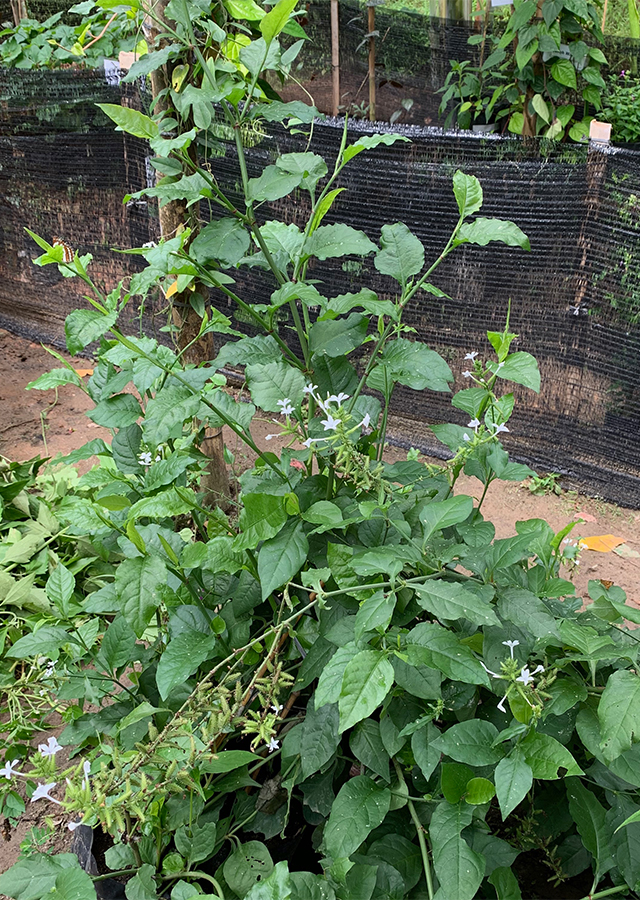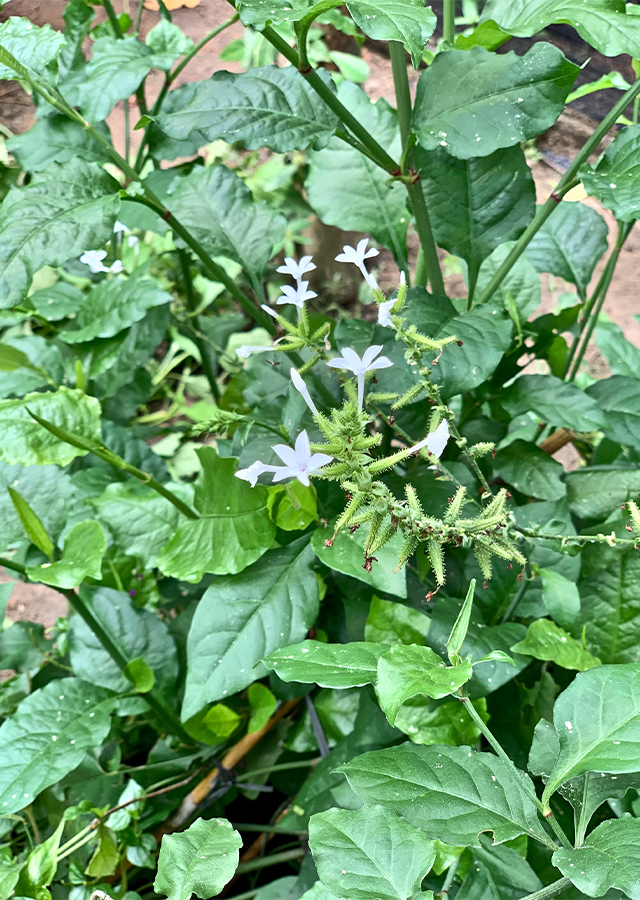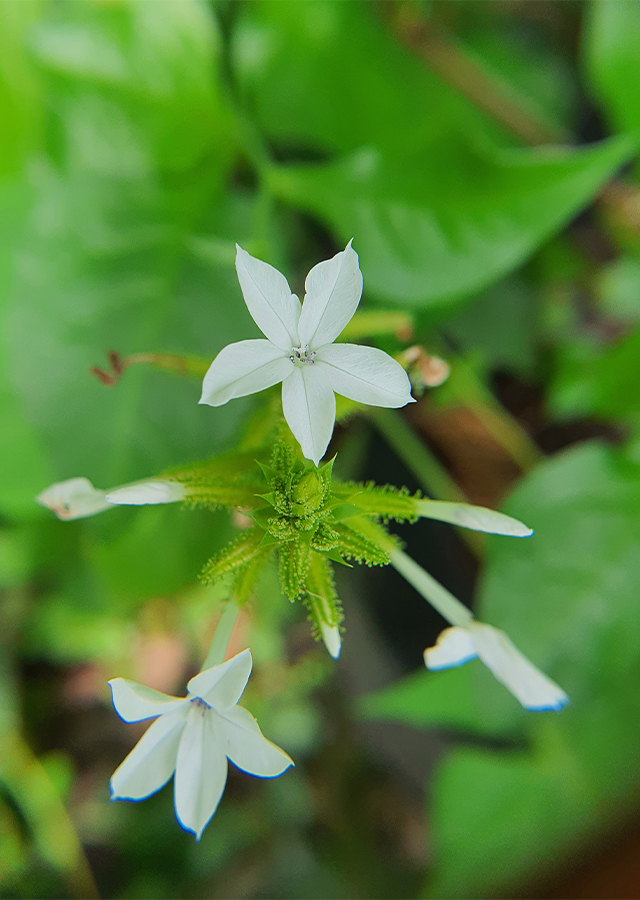Ceylon leadwort
Plumbago zeylanica L.
Plumbaginaceae
Location in our garden
Principal



Synonym
Findlaya alba Bowdich
Molubda scandens (L.) Raf.
Plumbagidium scandens (L.) Spach
Habitus
Shrubs. A spreading or somewhat climbing, half-woody plant, 1 to 2 m high.
Part Used
The Whole Plant
Growing Requirements
Full Sunshine
Need Shade
Habitat
Forest
Shrublands
Grassland
Overview
Ceylon leadwort occurs throughout the tropics and subtropics. It possibly originates from South-East Asia, from where it may have been distributed as a medicinal plant and ornamental. It occurs throughout most of tropical Africa. In Africa, this plant is only locally used. Herbalists collect the plants from the wild or cultivate them in their backyard for personal use and to supply the local markets.
Vernacular Names
Bai hua dan (Chinese), Celaka putih (Malaysia), Bleiwurz (German), Chitramulika (Kanada), Sangdikit (Tagalog-Philippines), Ensain (Afrikaans), Hiliee (Hawaiian).
Agroecology
Almost exclusively found in rather open, human-created habitats such as savannah, forest edges, and fallow fields, at elevations up to 1,000 m. Disturbed, arid habitats such as sand dunes, dry forests, and shrubland in Hawaii. Prefers a position in full sun or partial shade. Prefers slightly acidic soil. Plants can flower throughout the year.
Morphology
- Stems - erect, trailing or climbing, wiry, diffusely branched, glabrous, with prominent longitudinal ridges and often with white waxy dots.
- Leaves - alternate, simple and entire; stipules absent; petiole 0–5 mm long with small auricles present in young leaves; blade ovate, ovate-lanceolate, elliptical or oblong, 2.5–13 cm × 1–6 cm, base cuneate, apex acute, acuminate or obtuse, with white waxy dots underneath.
- Flowers - bisexual, regular, 5-merous, sweet-scented; pedicel 1–2 mm long; calyx tubular, 7–11 mm long, 5-ribbed, with stalked glands along ribs, lobes up to 1.5 mm long.
- Fruits - an oblong capsule 7.5–8 mm long, apex acute with 5 furrows, 1-seeded.
- Seeds - oblong, 5–6 mm long, reddish-brown to dark brown.
Cultivation
It can be propagated by seeds, rooted shoots from the base of the plant, or by semi-ripe cuttings, treated with a growth hormone.
Chemical Constituents
Plumbagin, alkaloids, flavonoids, glucosides, saponins, steroids, tannins, polyphenol, anthraquinone, isoshinanolone, plumbagic acid, β-sitosterol, 4-hydroxybenzaldehyde, trans-cinnamic acid, vanillic acid, 2, 5-dimethyl-7-hydroxychromone, indole-3-carboxaldehyde.
Traditional Medicinal Uses
- As a treatment for a range of skin problems, intestinal worms, testicular lesions, and testis-weight reduction.
- The whole plant, but especially the root, is abortifacient, acrid, diaphoretic, emmenagogue, and rubefacient.
- Plumbagin has shown anti-implantation, antimicrobial, antiplasmodial, anticancer, and antifertility activities. It is also a powerful irritant. It has been found to prevent Escherichia coli and Staphylococcus aureus from developing resistance to antibiotics.
- The crushed leaves are applied as a poultice to treat leprosy, scabies, ringworm, dermatitis, acne, sores, ulcers of the leg, hemorrhoids, and hookworm, as well as rheumatism and headache.
- The powdered roots are used as a blistering agent on the skin.
- The taproots, bark, and leaves, combined with salt and papaya fruit (Carica papaya) are used as a treatment for swellings.
Part Used
Reference Sources
- Fern, Ken (2014). Useful Tropical Plants. Plumbago zeylanica. http://tropical.theferns.info/viewtropical.php?id=Plumbago+zeylanica. 16-07-2020.
- Tyagi. Richa, Menghani. Ekta (2014). A Review on Plumbago zeylanica: A Compelling Herb. India. http://www.ijpsr.info/docs/IJPSR14-05-04-008.pdf. 13-08-2020.
- PROTA4U. (No date). Plumbago zeylanica L. https://prota4u.org/database/protav8.asp?g=pe&p=Plumbago+zeylanica+L#:~:text=Plumbago%20zeylanica%20can%20be%20mass,is%20potential%20for%20commercial%20cultivation. 14-08-2020.
- NIH. (2007). National Libary of Medicine. [Chemical constituents from aerial parts of Plumbago zeylanica Linn]. https://pubmed.ncbi.nlm.nih.gov/17727061/#:~:text=Results%3A%20Nine%20compounds%20were%20isolated,3%2Dcarboxaldehyde%20(IX). 30-01-2021.


